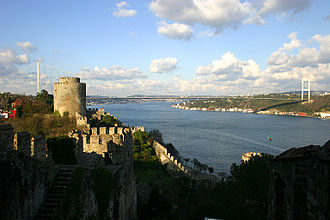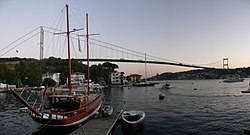Bosporus

The Bosporus or Bosphorus (Turkish: İstanbul Boğazı, lit. 'Istanbul strait')[1] is a strait which is straddled by the city of Istanbul that forms part of the boundary between the European part of Turkey and its Asian part (Anatolia). It connects the Black Sea with the Sea of Marmara. It is about 30 km long, with a maximum width of 3,700 metres at the northern entrance, and a minimum width of 700 metres between Kandilli and Aşiyan; and 750 metres between Anadoluhisarı and Rumelihisarı. The depth varies from 36 to 124 metres in midstream.
The shores of the strait are heavily populated as Istanbul is located on each side. Three bridges and one tunnel cross the strait.
Bosporus Media
Location of the Bosporus (red) relative to the Dardanelles (yellow) and the Sea of Marmara
Map of Constantinople (modern-day Istanbul), designed in 1422 by Florentine cartographer Cristoforo Buondelmonti. This is the oldest surviving map of the city, and the only surviving map that predates the Turkish conquest of 1453. The Bosporus is visible along the right-hand side of the map, wrapping vertically around the historic city.
The Bosphorus, with the Castles of Europe & Asia. 19th-century engraving by Thomas Allom. The castles are Rumelihisarı and Anadoluhisarı, respectively. The original is a watercolor available in the online collection of the Victoria and Albert Museum.
15 July Martyrs Bridge (Bosphorus Bridge), the first to be built across the Bosporus, completed in 1973
Fatih Sultan Mehmet Bridge, the second crossing built in 1988, looking from the Asian side towards Rumelihisarı on the European side of the Bosporus
References
Other websites
| Wikimedia Commons has media related to Lua error in Module:Commons_link at line 62: attempt to index field 'wikibase' (a nil value).. |
Coordinates: 41°07′10″N 29°04′31″E / 41.11944°N 29.07528°E







